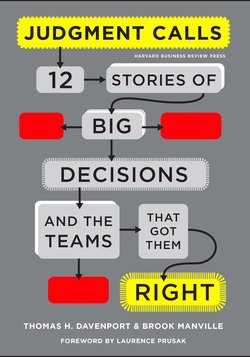Читать книгу Judgment Calls - Thomas H. Davenport - Страница 19
На сайте Литреса книга снята с продажи.
The Marathon Flight Readiness Review
ОглавлениеThe review proceeded as scheduled, however. More than 150 people gathered in the cavernous Operations Support Building 2 at Kennedy Space Center: engineers and managers from NASA centers, international partners, contractors, consultants, and former employees—“graybeards,” in NASA parlance—whose practical wisdom was valued by the generations that followed them. The astronauts who were to fly on STS-119 were there as well. Bill Gerstenmaier, head of space operations, who facilitated the meeting, wrote afterward, “I worked with all the astronauts very closely … their kids went to school with my kids, and here they are in the very room where we are discussing their safety.” Mike Ryschkewitsch remembers, “The kind of pressure we were under says if we make a bad mistake, people die … These are our friends and acquaintances and we are saying to them, ‘This is good enough for you to fly.’ ”
Ed Hoffman, director of NASA's Academy of Program/Project and Engineering Leadership, which is responsible for the knowledge sharing and project management development throughout the agency, observed that the immensity of the building, the sense of purpose, and the muted but palpable anxiety present that day reminded him of a service in a cathedral.
The meeting lasted nearly fourteen hours, far longer than any earlier FRR. It was an indication of both continuing uncertainty about technical issues and the openness of management to full and free discussion.
Despite the tremendous amount of analysis and testing that had been done, technical presentations on the causes of the broken valve on STS-126 and the likelihood of recurrence were incomplete and inconclusive. Unlike at most FRRs, new data streamed in during the review and informed the conversation. A chart reporting margins of safety included TBD (to be determined) notations.
Doubts about some test data arose when Gene Grush, lead of the Johnson Space Center's Concept Analysis Team, received a phone call from NASA's Stennis Space Center informing him that the program to evaluate the danger of material broken off a poppet breaching a fuel line had used the wrong material. “I had to stand up in front of that huge room and say, ‘Well there's a little problem with our testing. Yes, we did very well, but the hardness of the particle wasn't as hard as it should have been.’ That was very critical because that means that your test is no longer conservative. You've got good results, but you didn't test with the right particle,” he said.
While presentations and discussion continued in the Operations Support Building, Mike Ryschkewitsch brought more than one hundred other engineers into the conversation by way of an e-mail thread. He recalls, “People thought I was doing my own e-mail, but of course I wasn't. I'm sending messages out to all of these guys, with things like ‘I just heard this; do you all agree?’ … I sent maybe two to three hundred messages in all. It allowed me to have my own equivalent of a back room caucus … We are in the kitchen talking and having little arguments back and forth. Right at the very end of the very long day I put a poll out to everyone and said ‘Are we ready to go or not?’ ”
Commenting on the length and openness of the session, NASA chief safety and mission assurance officer Bryan O'Connor remarked, “Gerst [FRR chairman Bill Gerstenmaier] was absolutely open. He never tried to shut them down. Even though he could probably tell this is going to take a long time, he never let the clock … appear to be something that he was worried about.”
That is not to say that Gerstenmaier was indifferent to the launch schedule. Discovery was scheduled to deliver the final set of solar arrays needed to complete the International Space Station's electricity-generating solar panels, enabling the station to support an expanded crew of six. If STS-119 launched later than March 15, it would interfere with the March 26 mission of the Russian Soyuz vehicle to transport the Expedition 19 crew to the station, and would push back future U.S. launches. Late in the day, Gerstenmaier reminded the group of these risks to the Space Station program and the shuttle schedule. A few participants perceived his comments as pressure to approve the flight. Others saw it as appropriate context setting, making clear the broader issues that were part of their collective judgment. After he spoke, he gave the groups forty minutes to “caucus,” to discuss what they had heard during the day and decide on their recommendations. When they came back, he polled the groups. The engineering and safety organizations and some center directors in attendance made it clear that they did not find adequate rationale to fly STS-119.
NASA manager Steve Altemus summed up the decision: “as a community we never really got our arms around the true risks.” Bill McArthur, safety and mission assurance manager for the space shuttle at the time, said, “The fact that people were willing to stand up and say ‘We just aren't ready yet’ is a real testament to fact that our culture has evolved so that we weren't overwhelmed with launch fever.” That syndrome in the past had led dissenting voices to be discouraged and, even worse, treated with disdain. As the participants filed out of the meeting, Joyce Seriale-Grush said to Mike Ryschkewitsch, “This was really hard and I'm disappointed that we didn't have the data today, but it feels so much better than it used to feel, because we had to say that we weren't ready and people listened to us. It didn't always used to be that way.”
Clearly, the culture and norms around open discussions and speaking truth to power had changed considerably from the days of Challenger.
